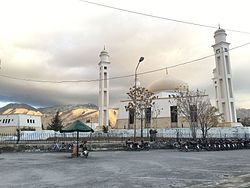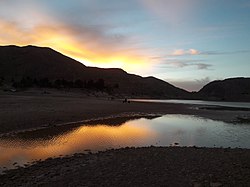|
Quetta District
Quetta (Urdu: کوئٹہ) is a district in the northwestern part of the Balochistan province of Pakistan. According to 2023 Pakistani census population of Quetta District is 2,272,290 (2.2 million). It is part of Quetta Division. The district is famous for its agriculture produce, most notably fruit orchards, including apples and grapes. The Hanna Valley is an area where almonds are grown. The population counted in the 1998 census was 760,000, while in 2010 it was estimated at 1,235,000,[3] and in 2017 at 2,275,699.[1][4] HistoryThe ancient name of Quetta was Shalkot, a term by which it is still known among the people of the country. The district was held in turns by the Ghaznavids, Ghurids, and Mongols, and towards the end of the fifteenth century was conferred by the ruler of Herat on Shah Beg Arghun, who, however, had shortly to give way before the rising power of the Mughals. The Ain-i-Akbari mentions both Shal and Pishin as supplying military service and revenue to Akbar, however these areas passed with Kandahar to the Safavids. On the rise of the Khilji power in Kandahar at the beginning of the eighteenth century, simultaneously with that of the Baloch in Kalat, Quetta and Pishin became i to the hand of british with the treaty of durand.[5] British EraDuring the 19th century Quetta (Shalkot) was captured by the British troops during the Second Anglo-Afghan War of 1879.[5] On the advance of the British Army of the Indus in 1839, Captain Bean was appointed the first Political Agent in Shalkot, and the country was managed by him on behalf of Shah Shuja-ul-mulk. After Sir Robert Sandeman's mission to Kalat in 1876, the Quetta Fort was occupied by his escort and the country was managed on behalf of the Khan of Kalat up to 1883, when it was leased to the British Government for an annual rent of Rs. 25,000 through a treaty between Khan and the British Empire. It was formed, with Pishin and Shorarud, into a single administrative charge in 1883. Up to 1888 Old Chaman was the most advanced post on the frontier; but, on the extension of the railroad across the Khwaja Amran, the terminus was fixed at its present site, 7 miles (11 km) from that place. The boundary with Afghanistan was finally demarcated in 1895–1896.[5] The city area of Shalkot was inhabited by the Kasi tribe and the surroundings were occupied by the Bazai tribe with a few other nomads including the tribes of Sulaimankhail, Kharoti, Nasar, and Baitanai. Being on the outskirts of Kandahar, it was not much developed. With the arrival of British troops, doors of development were opened. Very soon, people saw roads, trains and schools in the area.[5] Administrative divisionsSubdivisionsIn 1975, Quetta and Pishin were made separate districts. Quetta District today consists of two towns[6] and one sub-tehsil. Quetta District was designated as a City District in 2001, having two tehsils and one sub-tehsil with a total of 67 union councils.
Demographics
PopulationAs of the 2023 census, Quetta district has 288,459 households and a population of 2,595,492. The district has a sex ratio of 103.48 males to 100 females and a literacy rate of 56.29%: 65.06% for males and 46.96% for females.[10][11] 720,934 (31.74% of the surveyed population) are under 10 years of age.[12] 1,565,546 (60.32%) live in urban areas.[10] ReligionIn the 2023 census, Islam was the predominant religion at 98.59% of the population, while Christians were 1.1% of the population.[2] LanguageAt the time of the 2023 census, 59.95% of the population spoke Pashto, 15.51% Brahui, 7.38% Balochi, 2.95% Punjabi, 2.56% Urdu, 1.34% Sindhi, 1.09% Saraiki and 0.82% Hindko as their first language. Around 200,000 speakers of 'Other' languages were recorded in the census, mainly Hazaragi.[13] Hazaras, who speak Dari, are one of the other main ethnic groups in Quetta, having fled there as refugees since the 1990s. In 1998, 74% of the population resided in urban areas.[14] The major religion was Islam (96%), but there were also Christian (2.7%) and Hindu (0.5%) communities.[15] The most common first languages according to the 1998 census were Pashto (70%), Balochi (18%) and Punjabi (10%).[16] The number for Balochi speakers also included speakers of Brahui, who are normally bilingual with Balochi. Languages in the 1981 census were counted at the level of the household: Pashto was the language of 36% of households, Punjabi at 19%, Brahui at 17%, Urdu at 11% and Balochi at 5.1%.[17] There is also a population of Hazaras.[18]
Notable peopleReferences
Bibliography
External linksWikimedia Commons has media related to Quetta District.
|
||||||||||||||||||||||||||||||||||||||||||||||||||||||||||||||||||||||||||||||||||||||||||||||||||||||||||||||||||||||||||||||||||||||||||||||||||||||||||||||||||||||||||||||||||||||||||||||||||||||||||||||||||||||||||||||||||||||||||||||||||||||||||||||||||||||||||||||||||||||




